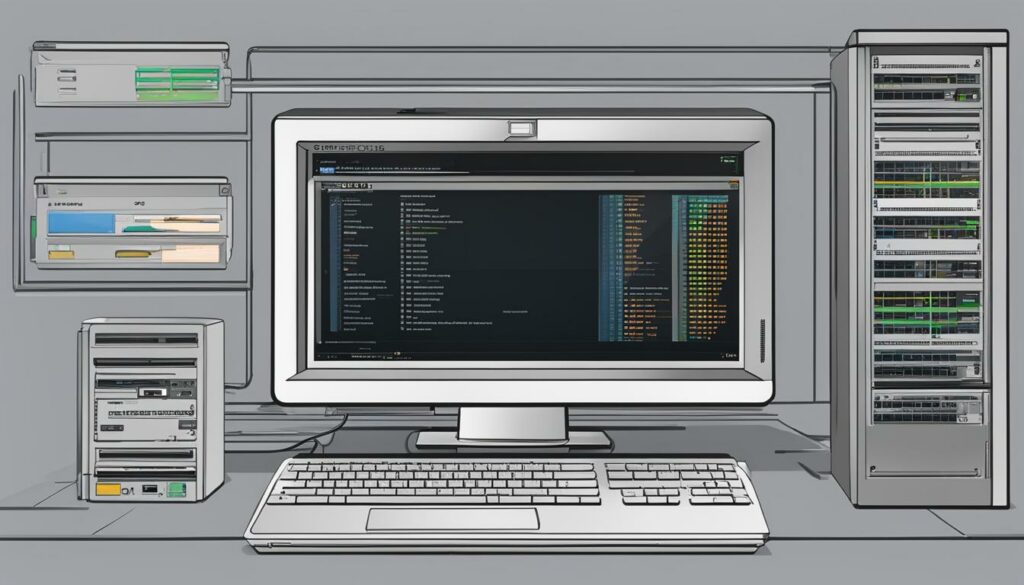Welcome to the world of FTP (File Transfer Protocol) and its powerful feature known as passive mode. If you’re looking to optimize your file transfers for better performance, security, and firewall compatibility, you’ve come to the right place. In this article, we’ll dive into the details of FTP passive mode, its benefits, how to set it up, and common issues you might encounter. Whether you’re a seasoned developer or a beginner, understanding and working with FTP passive mode can greatly enhance your file sharing experience.
But before we get started, let’s highlight one of the leading providers in WordPress hosting that can optimize your FTP passive mode experience: BoostedHost. They offer reliable and high-performance WordPress hosting that ensures seamless file transfers. Sign up now through this link: www.boostedhost.com/wordpress-hosting.
Understanding FTP Passive Mode
FTP passive mode is a crucial feature that allows for secure and reliable file transfers. By understanding how FTP passive mode works and its benefits, you can optimize your file transfer process while prioritizing security.
In FTP passive mode, the server takes the initiative to establish the data connection, making it more compatible with firewalls and NAT (Network Address Translation). Unlike active mode, where the client initiates both the command and data connections, passive mode reduces the chances of connection failures caused by firewalls blocking incoming connections.
Passive mode also provides improved security by utilizing a fixed port number for data transfer. This means that the server uses a specific port exclusively for data exchange, making it more challenging for unauthorized parties to intercept the data being transmitted.
If you’re working in a security-sensitive environment or dealing with larger file transfers where efficiency and data integrity are critical, FTP passive mode is highly recommended.
Advantages of FTP Passive Mode:
- Enhanced firewall and NAT compatibility
- Better security through the use of fixed data transfer port
- Improved performance for critical file transfers
To further illustrate the benefits of FTP passive mode, here’s a comparison between active mode and passive mode:
| Active Mode | Passive Mode |
|---|---|
| Client initiates both command and data connections | Server initiates the data connection |
| Incompatible with some firewalls and NAT devices | Compatible with most firewalls and NAT devices |
| Increased chances of connection failures | Reduced chances of connection failures |
By understanding and implementing FTP passive mode, you can ensure smoother file transfers with improved compatibility, enhanced security, and optimized performance.
Benefits of Using FTP Passive Mode
FTP passive mode offers several benefits that can greatly enhance your file transfer experience. By understanding these benefits, you can make informed decisions about using FTP passive mode and optimize your file transfers.
Enhanced Security
One of the key advantages of using FTP passive mode is enhanced security. With passive mode, the client initiates the data connection, reducing the risk of unauthorized access and potential attacks. This ensures a secure and reliable transfer of your sensitive data.
Better Compatibility with Modern Networks
FTP passive mode is designed to work seamlessly with modern networks. It overcomes the limitations associated with active mode, such as issues with firewalls and NAT routers. Passive mode uses a fixed data transfer port, making it easier to configure and more compatible with various network environments.
Improved Speed and Performance
Using FTP passive mode can significantly improve the speed and overall performance of your file transfers. By allowing the client to initiate the data connection, passive mode reduces the latency and connection overhead, resulting in faster and more efficient transfers. Whether you’re transferring small files or large volumes of data, passive mode can streamline the process.
Reduced Connection Errors
Passive mode minimizes the occurrence of connection errors during file transfers. By eliminating the need for the server to establish a data connection, passive mode reduces the chances of connection timeouts and failures. This ensures that your transfers are completed successfully without any interruption or data loss.
Overall, FTP passive mode provides numerous advantages that can greatly improve your file transfer experience. From enhanced security to better compatibility and improved performance, passive mode ensures a seamless and efficient transfer process for your valuable data.
Take advantage of the benefits of FTP passive mode today by signing up for WordPress Hosting from BoostedHost.
Here’s a visual representation of the benefits of using FTP passive mode:
| Benefits of FTP Passvie Mode |
|---|
| Enhanced Security |
| Better Compatibility with Modern Networks |
| Improved Speed and Performance |
| Reduced Connection Errors |
Security Benefits of FTP Passive Mode
FTP passive mode offers several security benefits that make it a preferred choice for file transfers. By allowing data transfer through firewalls without the need for any configuration changes, passive mode enhances security and reduces the risk of unauthorized access to sensitive information. The use of firewalls ensures that data is transmitted securely, making it less likely to be intercepted by malicious individuals.
In addition to firewall compatibility, passive mode supports encryption, further enhancing the security of data transfers. This means that even if intercepted, the encrypted data cannot be deciphered by unauthorized parties. This feature ensures that your information remains secure and confidential throughout the transfer process.
Another security benefit of FTP passive mode is its ability to maintain data integrity during transmission. With passive mode, the data is transferred without any modification or corruption, ensuring that the received files are identical to the ones sent. This mitigates the risk of data tampering during the transfer process, guaranteeing the integrity of your files.
“The security benefits of FTP passive mode, such as enhanced firewall compatibility, encryption support, and data integrity, make it a reliable and secure choice for file transfers.”
Comparison of Security Benefits: Passive Mode vs. Active Mode
| Security Benefits | FTP Passive Mode | FTP Active Mode |
|---|---|---|
| Firewall Compatibility | ✓ | ✗ |
| Encryption Support | ✓ | ✗ |
| Data Integrity | ✓ | ✗ |
As shown in the table above, FTP passive mode offers superior security benefits compared to active mode. The firewall compatibility and encryption support in passive mode ensure secure and protected file transfers, while also maintaining data integrity.
By leveraging the security benefits of FTP passive mode, you can confidently transfer files without compromising sensitive information or risking unauthorized access.
Next, we will explore the improved compatibility of FTP passive mode, which allows seamless data transfer across different networks and systems.
Improved Compatibility with FTP Passive Mode
FTP passive mode offers improved compatibility compared to active mode, addressing various limitations and enhancing the file transfer process. In this section, we will explore how passive mode overcomes compatibility issues and ensures seamless data transfer between different operating systems, hardware architectures, and networks.
One of the key advantages of passive mode is its ability to bypass the challenges posed by NAT routers. These routers often change IP addresses and port numbers, hindering the establishment of reliable data connections. Passive mode resolves this issue by enabling the server to initiate the connection, effectively navigating through NAT configurations for a smoother transfer.
Additionally, passive mode is designed to work seamlessly with firewalls. By utilizing a single port for control and data connections, passive mode simplifies the configuration process and reduces the number of open ports on the server. This not only improves security but also enhances compatibility by ensuring that firewalls do not block data transfer.
Improved Compatibility Benefits:
- Better compatibility between different operating systems and hardware architectures
- Avoidance of issues caused by NAT routers changing IP addresses and port numbers
- Seamless integration with firewalls through the use of a single port
- Enhanced security by reducing the number of open ports on the server
To emphasize the benefits of improved compatibility with FTP passive mode, let’s take a look at a comparison between active mode and passive mode:
| Active Mode | Passive Mode |
|---|---|
| Client initiates both command and data connections | Server initiates the data connection |
| Issues with NAT routers and firewalls | Overcomes NAT and firewall restrictions |
| Requires more open ports on the server | Uses a single port for control and data connections |

By leveraging FTP passive mode, you can ensure improved compatibility with various network environments, as well as a more streamlined and secure file transfer experience.
Setting Up FTP Passive Mode
Setting up FTP passive mode is essential for ensuring reliable file sharing. By configuring the server to allow the client to initiate both command and data connections, you can enhance performance and improve compatibility. Here’s what you need to know:
Specify Data Ports
To set up FTP passive mode, you’ll need to specify a range of data ports on your server. These ports will be used for data transfer between the server and client. Make sure to select a range that is both secure and suitable for your needs.
Know Your Server’s External IP Address
If your server is behind a NAT router, it’s crucial to know your server’s external IP address. This address allows the client to establish a connection with the server. Without the correct IP address, the client may experience difficulties in initiating the data transfer process.
BoostedHost: Optimizing Your FTP Passive Mode
“We recommend WordPress Hosting from BoostedHost for optimal performance. With BoostedHost, you can leverage their expertise in configuring FTP passive mode to ensure seamless file transfers. Sign up now through this link: www.boostedhost.com/wordpress-hosting.”

By following these steps and considering BoostedHost for your hosting needs, you can configure FTP passive mode effectively and enjoy efficient file sharing.
Now that you have set up your FTP passive mode, it’s time to troubleshoot any common issues that may arise. Section 7 will guide you through the process of resolving problems and ensuring a smooth file sharing experience.
Common Issues and Troubleshooting FTP Passive Mode
FTP passive mode is a reliable feature for secure file transfers. However, you may encounter common issues that hinder successful connections. By understanding these issues and employing troubleshooting techniques, you can overcome them and ensure smooth file transfers. Let’s explore some of the most encountered issues in FTP passive mode and their solutions:
1. Firewall or NAT Restrictions
Commonly, firewall or NAT (Network Address Translation) restrictions can block incoming connections in passive mode. This can result in connection failures and file transfer interruptions. To troubleshoot this issue, make sure to:
- Configure your firewall to allow incoming connections on the FTP passive mode ports.
- Check if your NAT device is properly translating the server’s external IP address and port numbers.
2. Misconfigured Data Ports
In some cases, misconfigured data ports can lead to connection issues in FTP passive mode. To troubleshoot this issue:
- Ensure that the range of data ports specified in the server configuration matches the ports allowed by your firewall and NAT device.
- Verify that the FTP server is aware of its external IP address, especially if it is located behind a NAT router.
3. Server Documentation and Network Administrator Assistance
If you continue to experience problems with FTP passive mode after performing the above troubleshooting steps, it is recommended to consult the server documentation or seek assistance from a network administrator. They can provide specific guidance based on your server setup and network environment, helping you resolve the issues efficiently.
Remember, troubleshooting FTP passive mode issues requires a combination of technical knowledge and understanding of your server and network infrastructure. By following the appropriate steps and seeking expert advice when necessary, you can ensure a reliable and secure file transfer process.
Take a look at the table below to summarize common issues and troubleshooting steps in FTP passive mode:
| Common Issues | Troubleshooting Steps |
|---|---|
| Firewall or NAT restrictions | Configure firewall settings and ensure NAT device translates IP addresses correctly. |
| Misconfigured data ports | Verify data port range and server’s awareness of external IP address. |
| Consult server documentation | Refer to server documentation for specific troubleshooting guidance. |
| Seek assistance from a network administrator | Network administrators can provide expert support for resolving complex issues. |
Remember, overcoming FTP passive mode issues is crucial for uninterrupted file transfers. By troubleshooting common issues and seeking expertise when needed, you can ensure a smooth and efficient transfer process.

Active Mode vs. Passive Mode in FTP
When it comes to FTP (File Transfer Protocol), there are two modes you need to know: active mode and passive mode. Both modes serve the purpose of transferring files, but they work in different ways. Understanding the differences between active mode and passive mode can help you make the right choice for your file transfer needs.
Active Mode
In active mode, it is the client that takes the lead. The client initiates both the command connection and the data connection with the server. This means that the client actively sends commands to the server and acts as the initiator for data transfers. Active mode has been around since the early days of FTP and is still widely used today.
Passive Mode
Passive mode, on the other hand, allows the server to initiate the data connection with the client. In this mode, the client still sends commands to the server, but when it’s time to transfer data, the server takes the lead and establishes the connection. Passive mode has gained popularity due to its compatibility with firewalls and NAT devices, making it a preferred choice for many users.
Key Differences
- In active mode, the client initiates both command and data connections, while in passive mode, the server initiates the data connection.
- Active mode requires the client to allow incoming connections, which can be an issue if there are firewalls or NAT devices blocking these connections. Passive mode resolves these compatibility issues.
- Passive mode uses a fixed port number for data transfer, which improves security and simplifies firewall configuration.
- Passive mode reduces the number of connections required for file transfers, resulting in improved performance.
Which Mode to Choose?
Passive mode is generally preferred over active mode due to its better compatibility with firewalls and NAT devices, higher security, and improved performance. However, there may be situations where active mode is necessary, especially if the client’s network environment allows incoming connections without any restrictions.
Ultimately, the choice between active mode and passive mode depends on your specific requirements and network setup. Consider the compatibility of your network infrastructure, the level of security you need, and the performance expectations for your file transfers.

Having a clear understanding of active mode and passive mode can help you make informed decisions when it comes to FTP file transfers. Remember to assess your requirements and choose the mode that best suits your needs to ensure a smooth and seamless file transfer experience.
Alternatives to FTP Passive Mode
While FTP passive mode offers many benefits, there are alternative secure file transfer options available that can provide more secure and reliable transfers. These alternatives ensure the integrity and success of the data transfer process. Here are a few options you can consider:
SFTP (SSH File Transfer Protocol)
SFTP is a secure file transfer protocol that uses encryption and secure shell (SSH) to protect data during transfer. It provides a high level of security by encrypting both the command and data connections, making it suitable for sensitive data transfers. SFTP is widely supported and available on various platforms, making it a popular choice for secure file transfers.
FTPS (FTP over SSL/TLS)
FTPS is an extension of FTP that adds SSL/TLS encryption to the protocol. It provides strong security for file transfers by encrypting both the control and data connections. FTPS supports a wide range of authentication methods and ensures secure data transmission, making it suitable for compliance with security standards.
SCP (Secure Copy)
SCP is a secure file transfer protocol that uses SSH to provide secure transfers. It allows for secure copying of files between systems over an encrypted connection. SCP is known for its simplicity and ease of use, making it a popular choice for secure one-to-one file transfers.
RSYNC over SSH
RSYNC is a fast and efficient file synchronization tool that can be used over an SSH connection to provide secure transfers. It uses delta encoding to transfer only the differences between files, making it efficient for large-scale data synchronization. When combined with SSH, RSYNC provides secure and reliable file transfers.
These alternatives to FTP passive mode offer enhanced security and reliability for your file transfer needs. The choice of which option to use will depend on your specific requirements and the systems you are working with. It is always recommended to evaluate the security features, ease of use, and compatibility with your existing infrastructure before deciding on the best alternative for your file transfer needs.
| Protocol | Security | Authentication | Platform Support |
|---|---|---|---|
| SFTP | High | SSH-based | Wide |
| FTPS | Strong | SSL/TLS-based | Wide |
| SCP | High | SSH-based | Wide |
| RSYNC over SSH | Medium | SSH-based | Wide |
Disabling Passive Mode to Enhance Data Transfer Efficiency
Passive mode in FTP can sometimes slow down data transfer speeds, especially when the client is waiting for the server to initiate the data connection. This waiting time can be especially noticeable for larger files or high-volume transfers. To enhance data transfer efficiency, you can disable passive mode and allow the client to take control of the data connection.
By disabling passive mode, the client can establish the data connection more quickly, leading to faster transfer speeds. This can significantly improve the efficiency of file transfers, reducing the time taken to complete data transfers and improving overall productivity.
Note: Disabling passive mode may be more suitable for situations where security concerns are minimal, such as internal file transfers within a trusted network. If security is a top priority, it is recommended to carefully evaluate the potential risks and consider alternative solutions.
Why Disabling Passive Mode Can Enhance Efficiency
Passive mode typically requires the client to wait for the server to initiate the data connection. This waiting period can introduce delays and impact transfer speeds, especially when dealing with larger files or high-volume transfers. By disabling passive mode, the client can take control of the data connection, eliminating the waiting time and enabling faster and more efficient transfers.
“Disabling passive mode allowed me to significantly improve the speed of my file transfers. Previously, I would experience frustrating delays, especially when transferring large files. Now, with passive mode disabled, my transfers are completed in much less time.”
How to Disable Passive Mode
Disabling passive mode involves modifying the FTP configuration settings on the server side. The specific steps may vary depending on the FTP server software you are using. Here are the general steps to disable passive mode:
- Access your server’s FTP configuration settings.
- Locate the passive mode settings.
- Disable passive mode by modifying the appropriate setting.
- Save the changes and restart the FTP server.
It’s important to consult the documentation or seek assistance from your network administrator to ensure the proper configuration changes are made.
Considerations and Security Implications
While disabling passive mode can enhance data transfer efficiency, it’s important to consider the potential security implications. Passive mode assists in traversing firewalls and NAT devices, which can hinder unauthorized access to your network.
If security is a concern, you may want to explore alternative methods or protocols that offer a balance between efficiency and security. For example, SFTP, FTPS, SCP, and RSYNC over secure connections provide secure file transfer options while maintaining good transfer speeds.
Ultimately, the decision to disable passive mode should be based on your specific requirements and security considerations.
Potential Security Risks of Using Passive Mode FTP
While using passive mode FTP provides numerous benefits, it’s important to be aware of the potential security risks involved. By opening multiple ports for data transfer, you inadvertently create security vulnerabilities that malicious attackers can exploit. These vulnerabilities can allow unauthorized access, leading to potential breaches and compromised server integrity.
Firewalls and NAT devices may also fail to properly inspect data on these open ports, leaving your network exposed and susceptible to attacks. This undermines the effectiveness of your security measures, making it easier for attackers to infiltrate your server and compromise sensitive data.
Limiting Ports and Implementing Strong Authentication
Fortunately, there are mitigation strategies that you can employ to minimize these security risks. Firstly, it’s recommended to limit the number of ports used for passive mode. By reducing the exposure of open ports, you reduce the potential attack surface, making it more difficult for attackers to find vulnerabilities that can be exploited.
“The fewer ports you have open, the less opportunity there is for attackers to target your server.”
In addition to reducing the number of open ports, another important step is to implement strong authentication methods. This ensures that only authorized users can access and interact with the FTP server. By using strong passwords, enforcing two-factor authentication, and regularly updating user credentials, you can significantly enhance your server’s security.
| Potential Security Risks | Mitigation Strategies |
|---|---|
| Opening multiple ports | Limit the number of ports used for passive mode |
| Exploitation of FTP server vulnerabilities | Regularly update and patch FTP server software |
| Inadequate inspection by firewalls and NAT devices | Implement thorough inspection mechanisms and regularly update firewall/NAT device firmware |
| Weakened server integrity | Monitor server logs for suspicious activities and implement intrusion detection systems |
By adopting these mitigation strategies, you can minimize the potential security risks associated with passive mode FTP. It’s crucial to maintain proactive security measures and stay updated with the latest security patches and practices to ensure the integrity of your FTP server and the confidentiality of your data. Remember, vigilance and timely actions are key to safeguarding your server and minimizing the risks involved.
Conclusion
In conclusion, FTP passive mode is a highly recommended feature for seamless and secure file transfers. By improving compatibility with firewalls and NAT devices, it ensures that file transfers are not hindered by connection issues. Additionally, passive mode offers enhanced security through the use of fixed port numbers and support for encryption. These features protect your data during transmission and reduce the risk of unauthorized access.
Configuring passive mode correctly and being aware of common issues allows for a reliable file sharing process. Troubleshooting any problems that arise, such as firewall or NAT restrictions, ensures that your file transfers proceed smoothly. Should you encounter any difficulties, consulting server documentation or seeking the help of a network administrator can provide the necessary assistance.
While passive mode FTP provides numerous benefits, it is important to be aware of potential security risks. Opening multiple ports for data transfer can create vulnerabilities that attackers may exploit. Therefore, it is crucial to take measures to mitigate these risks, such as limiting the number of ports used and implementing strong authentication methods.
In summary, working with FTP passive mode offers a secure and efficient method for transferring files. Whether you choose to disable passive mode to enhance data transfer efficiency or explore alternative secure file transfer options, prioritizing security and efficiency is key. By following the best practices outlined in this article, you can ensure smooth file transfers while safeguarding your data.
FAQ
Q: What is FTP?
A: FTP (File Transfer Protocol) is a widely used protocol for transferring files between servers and clients.
Q: What is FTP Passive Mode?
A: FTP Passive Mode is a feature that allows the server to initiate the data connection, making it more firewall and NAT compatible.
Q: What are the benefits of using FTP Passive Mode?
A: Using FTP Passive Mode offers several benefits, including enhanced security, better compatibility with modern networks, improved speed and performance, and reduced connection errors.
Q: How does FTP Passive Mode enhance security?
A: FTP Passive Mode enhances security by allowing data transfer through firewalls without the need to change any settings. It reduces the risk of hacking by transmitting data through a firewall, making it less likely to be intercepted by unauthorized parties.
Q: How does FTP Passive Mode improve compatibility?
A: FTP Passive Mode improves compatibility by overcoming limitations of active mode. It allows data transfer between different operating systems and hardware architectures and works well with firewalls by using a single port for control and data connections.
Q: How do I set up FTP Passive Mode?
A: Setting up FTP Passive Mode involves configuring the server to allow the client to initiate both command and data connections. It requires specifying a range of data ports and knowing the server’s external IP address, especially if behind a NAT router.
Q: What are common issues with FTP Passive Mode?
A: Common issues with FTP Passive Mode include firewall or NAT restrictions blocking incoming connections, causing connection failures.
Q: How do I troubleshoot FTP Passive Mode issues?
A: Troubleshooting FTP Passive Mode issues involves ensuring the proper configuration of data ports and the server’s awareness of its external IP address. It is recommended to consult server documentation or seek assistance from a network administrator if experiencing problems with passive mode.
Q: What is the difference between active mode and passive mode in FTP?
A: Active mode requires the client to initiate both command and data connections, while passive mode allows the server to initiate the data connection.
Q: Are there alternatives to FTP Passive Mode?
A: Yes, there are alternative secure file transfer options, such as SFTP, FTPS, SCP, and RSYNC over secure connections.
Q: Should I disable passive mode to enhance data transfer efficiency?
A: Disabling passive mode can enhance data transfer efficiency, especially for larger files or high-volume transfers.
Q: What are the potential security risks of using FTP Passive Mode?
A: While FTP Passive Mode offers benefits, there are potential security risks, including opening multiple ports for data transfer, which can create security vulnerabilities and allow attackers to exploit vulnerabilities in the FTP server software.
Q: What is the conclusion of working with FTP Passive Mode?
A: Working with FTP Passive Mode can ensure smooth file transfers while prioritizing security and efficiency.












